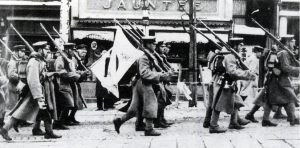Plenty of people have compared the January 6, 2021 attempted insurrection at the U.S. Capitol to the beginning of China’s Cultural Revolution in summer 1966. Donald Trump’s order to “fight like hell” and Mao Zedong’s exhortation to his supporters to “bombard the headquarters” seem eerily aligned, and the violent tribalism of both the Trumpist Capitol invaders and China’s Red Guards is undeniable.
But a 1936 event in Japan may prove a more prescient parallel. This month we mark the 85th anniversary of the infamous ni-ni-roku jiken, the February 26 Incident in Tokyo, when mid-rank officers in the Imperial Japanese Army (IJA) launched a coup attempt that became a watershed in the country’s path toward theological militarism and catastrophe.
Socioeconomic and Cultural Dislocation as Breeding Pools
From the mid-1920s, Japan exhibited increasingly visible income inequality. Many in the working and rural classes came to consider the economic powerhouses of the day, the zaibatsu corporate conglomerations, as economically predatory, working in collusion with corrupt government officials (the “deep state” of the day), and in thrall to globalism, which (they thought) profited the elites only and tarnished the nation’s supposed purity (more on this below).
The global depression that started in 1929 proved especially tragic for Japan’s tenant farmers, about two-thirds of all Japanese farmers at the time. Tenant farming notoriously supports little more than subsistence living even in stable times – during the depression years, tenant families were so often forced into extreme measures such as selling daughters into prostitution that a cottage industry arose of brokers for these sales. Scholars have long discussed the connection between severe rural poverty in Japan in the 1930s and mounting extremism – the mid-rank and lower officers who led the 2-26 coup attempt were largely from rural regions that had become economically devastated.
Meanwhile, by the mid-1930s in Japan, an increasingly cultish national mythology, expressed in a single word, kokutai (“national polity”), bound together supposed divine favor with a zeal for orthodoxy, no small amount of xenophobia, and ostracism at least for heresy. Among two major factions in the Japanese military, which had veto power over the government, the more virulent was the Kodoha, powered by the disaffected young officers mentioned above. Kodoha adherents called for a “Showa Restoration” that would cleanse the kokutai of their version of “deep state” collaborators and globalists.
Factional Defeat Begets a Backlash
By the first weeks of 1936, the Kodoha had been largely overmatched by the other main faction of the military, the Toseiha, with one of the Kodoha faithful on trial for an assassination of a Toseiha leader. The First Division of the IJA, the core of the Kodoha faction, had just been given transfer orders to Manchuria, so the Kodoha militants concluded that time was working against them – that recent political developments compelled them to attempt an overthrow of the corrupt state and “evil advisors to the Emperor.” The roughly 1,500 insurrectionists styled themselves the Righteous Army and fashioned their own battle flag, which proclaimed their mission: “Revere the Emperor, Destroy the Traitors.”
On February 26, 1936, marauding bands of this army murdered three government leaders, while four others escaped (just as the January 6 insurrectionists’ main targets, including House Speaker Nancy Pelosi and Vice President Mike Pence, escaped). One of the bands swarming Tokyo broke into the headquarters of the Asahi Shinbun, enacting what they considered divine retribution against this liberal, traitorous newspaper company by trashing the office.
The ni-ni-roku coup attempt failed. The leaders were arrested; 19 were executed, more committed suicide, and dozens of their superiors in rank were purged for aiding and abetting the violence, though no top military officer was convicted of any crime. But the rival Toseiha had their collective hand strengthened. The Toseiha’s leader, Tojo Hideki, consolidated power around himself over the coming few years and became a key architect of Japan’s invasion of China in 1937, the subsequent military campaigns that led to the murder of millions around the region, the deaths of millions of Japanese as well, and the utter destruction of Imperial Japan. Tojo’s nickname was The Razor – he was deeply anti-Western and a devoted adherent of the kokutai mythology, but he had the political cunning and the resolute tactical focus to excel over his rivals. Among other things, the Toseiha leaders sought to excuse the insurrectionists’ kokutai motives, which they considered patriotic.
In this century, over in the United States, the skirmishes between factions of the Republican Party continue, and will for some time, but it seems plausible that those Congressional veterans who are a bit more clever and politically deft, though remaining adherents of the overall mythology, may prevail over the Trumpist hotheads. But that shouldn’t be cause for relief. As the example of 1930s Japan proved, a savvier version of the same dangerous undercurrents can achieve a level of destructiveness that exceeds what we’ve seen so far.
John D. Van Fleet’s first book, “Tales of Old Tokyo,” a scrapbook history of the city from the mid-19th to the mid-20th century, was published in 2015. His current project, “Quarreling Cousins – Japan and China from Antiquity to 2022,” is coming out in essay form, gradually. He lives in Shanghai.

































